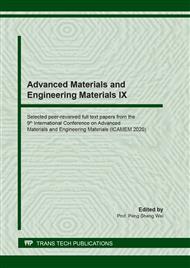[1]
Lv, Y., et al, Recent advances of nickel-aluminum bronze (NAB), Rare Metal Materials & Engineering (2016).
Google Scholar
[2]
Moussa, M. E., M. A. Waly, and M. Amin, Effect of high intensity ultrasonic treatment on microstructural modification and hardness of a nickel-aluminum bronze alloy, J. Alloys Compd. 741(2018):804-813.
DOI: 10.1016/j.jallcom.2018.01.218
Google Scholar
[3]
Culpan, E. A., and J. T. Barnby, The metallography of fracture in cast nickel aluminium bronze, Journal of Materials Science 13.2(1978):323-328.
DOI: 10.1007/bf00647776
Google Scholar
[4]
Thossatheppitak, Borpit, et al, Mechanical Properties at High Temperatures and Microstructures of a Nickel Aluminum Bronze Alloy, Advanced Materials Research 683(2013):82-89.
DOI: 10.4028/www.scientific.net/amr.683.82
Google Scholar
[5]
Lv, Yuting, et al, Influences of heat treatment on fatigue crack growth behavior of NiAl bronze (NAB) alloy, Journal of Materials Research 30.20(2015):3041-3048.
DOI: 10.1557/jmr.2015.282
Google Scholar
[6]
G.R.E.A. Culpan, Microstructural characterization of cast nickel aluminium bronze, J. Mater. Sci., 13 (8) (1978) 1647-1657.
DOI: 10.1007/bf00548728
Google Scholar
[7]
Hasan, F., et al, The morphology, crystallography, and chemistry of phases in as-cast nickel-aluminum bronze, Metallurgical Transactions A 13.8(1982):1337-1345.
DOI: 10.1007/bf02642870
Google Scholar
[8]
Culpan, E. A., and G. Rose, Microstructural characterization of cast nickel aluminium bronze, Journal of Materials Science 13.8(1978):1647-1657.
DOI: 10.1007/bf00548728
Google Scholar
[9]
Oh-Ishi, Keiichiro, and T. R. Mcnelley, Microstructural modification of as-cast NiAl bronze by friction stir processing, Metallurgical and Materials Transactions A (Physical Metallurgy and, Materials Science) 35.9(2004):2951-2961.
DOI: 10.1007/s11661-004-0242-1
Google Scholar
[10]
Lv, Yuting, et al, Investigation of microstructure and mechanical properties of hot worked NiAl bronze alloy with different deformation degree, Materials Science and Engineering: A 643(2015):17-24.
DOI: 10.1016/j.msea.2015.06.078
Google Scholar
[11]
Anantapong, J., et al, Effect of hot working on microstructure evolution of as-cast Nickel Aluminum Bronze alloy, Materials & Design 60(2014):233-243.
DOI: 10.1016/j.matdes.2014.03.033
Google Scholar
[12]
Z. B. Qin, Q. Zhang, Q. Luo, et al, Microstructure design to improve the corrosion and cavitation corrosion resistance of a nickel-aluminum bronze, Corros. Sci. 139 (2018) 255–266.
DOI: 10.1016/j.corsci.2018.04.043
Google Scholar
[13]
Liang, Chien Lung, and K. L. Lin, The microstructure and property variations of metals induced by electric current treatment: A review, Materials Characterization 145(2018):545-555.
DOI: 10.1016/j.matchar.2018.08.058
Google Scholar
[14]
Samuel, Edwin I., A. Bhowmik, and R. Qin, Accelerated spheroidization induced by high intensity electric pulse in a severely deformed eutectoid steel, Journal of Materials Research 25.06(2010):1020-1024.
DOI: 10.1557/jmr.2010.0140
Google Scholar
[15]
Zhao, Zhiyong, et al, Fast recrystallization and phase transformation in ECAP deformed Ti–6Al–4V alloy induced by pulsed electric current, J. Alloys Compd. (2019).
DOI: 10.1016/j.jallcom.2019.01.328
Google Scholar
[16]
Sun, Yongan, et al, Improvement of surface resistance to cavitation corrosion of nickel aluminum bronze by electropulsing-assisted ultrasonic surface rolling process, Surface and Coatings Technology (2019).
DOI: 10.1016/j.surfcoat.2019.03.045
Google Scholar
[17]
Gao, Menglin, et al, Reverse evolution in nanoscale Cu-rich precipitates of an aged Fe–Cu alloy under electropulsing, Philosophical Magazine Letters 99.1(2019):1-9.
DOI: 10.1080/09500839.2019.1615147
Google Scholar
[18]
Elliottbowman, B, and R. Qin, The effects of electropulsing on metallic materials, (2015).
Google Scholar
[19]
R. Zhu, Y. Jiang, L. Guan, H. Li, G. Tang, Difference in recrystallization between electropulsing-treated and furnace-treated NiTi alloy, J. Alloys Compd. 658 (2016) 548-554.
DOI: 10.1016/j.jallcom.2015.10.239
Google Scholar
[20]
M.D. Fuller, et al, Microstructural transformations and mechanical properties of cast NiAl bronze: Effects of fusion welding and friction stir processing, Materials Science and Engineering: A 463.1-2(2007):128-137.
DOI: 10.1016/j.msea.2006.07.157
Google Scholar
[21]
Nelson EA, Microstructural effects of multiple passes during friction stir processing of nickel aluminum bronze, Thesis at Naval postgraduate school, Monterey, California; (2009).
Google Scholar


